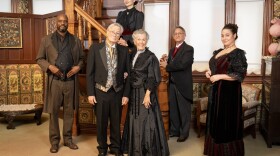SCOTT SIMON, host:
Aung San Suu Kyi is certainly Burma's best-known political prisoner. But the Nobel Peace Prize winner is just one of more than a thousand human rights activist who are imprisoned in that country. And international human rights groups say the Burmese army has displaced more than a million people within Burma, forcing a massive influx of refugees into neighboring countries.
(Soundbite of gunfire)
SIMON: Some human rights groups are trying to struggle against the military dictatorship there with a new weapon, the video camera.
Kweh Say is a refugee from eastern Burma whose been working with the group Burma Issues to videotape human rights abuses there. Kweh Say joins us from our studios in New York City. Kweh Say, thanks very much for being with us.
Mr. KWEH SAY (Human Rights Activist): Thank you.
SIMON: This must be dangerous work, to take a video camera and turn it on things that people there don't want the world to see.
Mr. SAY: Yes, it's true. It's really dangerous, because Burma's government does not allow any human rights organization or any media to enter Burma.
SIMON: What sort of things have you captured on your camera? What have you seen and been able to show to the world?
Mr. SAY: A village burned down by the Burma army, and village people displaced and hide in the deep jungle without enough food and security and without medical care.
SIMON: May I ask about your personal story and that of your family? You left Burma, as I understand, in 1975.
Mr. SAY: Yes, that's true. I left in my home village from 1975, and wandering around inside Burma until 1984. And I came to border and take refuge in Thailand in the refugee camp in April 1984.
SIMON: And your family is ethnic Karen, right?
Mr. SAY: Yes, ethnic Karen.
SIMON: Why was your family forced to leave?
Mr. SAY: Because Burma military dictatorship began a strong offensive towards Karen people in that area and moved many villagers down to the low land area to the relocation site and moved people to the refugee camp. So my family stayed there for a while and we found out there's not enough security, enough food for us, so our family decided to move to the border, to refugee camp.
SIMON: Do you find that people react to video more strongly than they do the spate of official reports that we've read over the past 20 years about the situation in Burma?
Mr. SAY: I would say that I personally feel that a video works better than written reports, as it tells story very clear and very shortly, because if you'll read - like the whole offensive report will take you a few hours. But with a video document, with only a few minutes, you can see the picture, you can hear the voice of the people suffering, and you can see their faces of suffering. That can tell a story deeper than a written report.
SIMON: Kweh Say, thank you very much.
Mr. SAY: Thank you very much.
SIMON: Kweh Say is a Burmese human rights activist with Burma Issues, speaking with us from New York.
And this is NPR News. Transcript provided by NPR, Copyright NPR.





